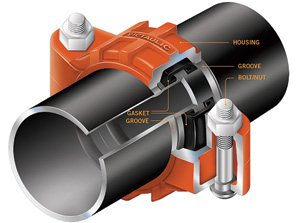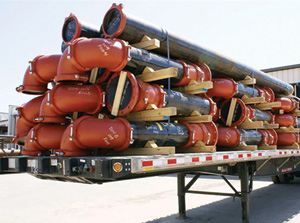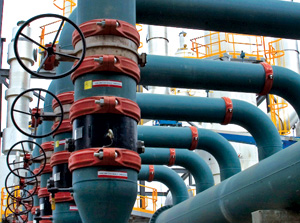Grooved Mechanical Piping Reduces Risk, Cost and Construction Schedules






September 18, 2009
BY Jim Renner
Owners and contractors building biodiesel facilities can reduce capital costs and risk, and realize design scalability by specifying grooved mechanical piping for utility and process piping systems. Grooved piping compresses construction schedules to get plants on line faster, minimizing project and financial risk.
Grooved mechanical pipe joining is a method of fabricating piping systems that eliminates the need for welding and flanging pipe. Grooved-end pipe, fittings, valves and accessories are joined with mechanical couplings that provide a secure, reliable union at every joint. These connections are designed to handle a variety of utility and process piping services. Grooved pipe solutions can be used on carbon steel, stainless steel and galvanized pipe, as well as high-density polyethylene (HDPE), fiberglass-reinforced pipe and American Water Works Association ductile iron pipe ranging in size from a half inch to 60 inches.
A grooved pipe joint is comprised of three core elements: the pipe groove; the gasket and coupling housings; and nuts and bolts (Figure 1). Grooves are cold-formed on the pipe ends with tooling specifically designed for this process. The coupling housing engages the grooved ends of each pipe, fitting or valve to be connected. A resilient, pressure-responsive elastomeric gasket provides a leak-tight seal, even under a vacuum. The coupling housing fully encloses the gasket, reinforcing the seal and securing its position. The coupling is fastened with two track head bolts and nuts.
Grooved mechanical piping has its roots in World War I, during which this innovation was used to deploy fuel and water to Allied forces on the front lines. The system proved beneficial over other joining methods, because as troops' positions changed, the pipes needed to be disassembled, transported and reassembled quickly and efficiently.
Today, the grooved pipe system still proves advantageous in critical fluid handling applications of a different kind-biodiesel fuel production. Grooved piping systems can be installed on a variety of biodiesel piping applications, including alcohol; caustic; chilled, cooling, potable, wash and demineralized water; fire protection; glycerin; instrument and plant utility air; oil feed; reverse osmosis; and wastewater treatment.
Time, Money and Risk Reduction
Ultimately, biodiesel facility owners want three things in the plant construction process: capital cost reduction, schedule compression and risk reduction. Capital costs are immense in industrial construction and, because financing is critical to companies building biofuel plants, every dollar that can be saved is significant, especially given the current lending and investment climate. However, there is funding available through such programs as the U.S. DOE's loan guarantees under the Recovery Act. The Act's 1705 Program funds renewable energy generation projects that begin construction before October 2011, providing these companies access to much-needed capital. With programs such as this, and the race to develop and commercialize next-generation biodiesel technologies, time is of the essence. The sooner a technology gets to market, the sooner the company can get others to adopt, license and otherwise leverage it. That's where speed of construction can prove a significant competitive advantage. But in construction, contractors and owners face risks such as weather delays, variable labor costs, construction delays, safety issues and capital cost overruns, all of which need to be addressed.
Grooved piping systems have multiple benefits that reduce total installed costs, save time and reduce risk during construction and maintenance, resulting in faster production of biodiesel.
Construction By reducing fabrication costs, material handling and transport costs and labor time, grooved piping can reduce total installed costs by as much as one-third compared to welding and flanging. Even within the controlled environment of a fabrication shop, welded and flanged pipe fabrication is a time-consuming and costly process. For example, a typical weld/flange fabrication shop would require 15.4 man-hours to weld and flange a fabricated spool of 14-inch pipe consisting of two three-foot sections of pipe, a valve, a tee-fitting and a 90-degree elbow, representing 56 inches total diameter of pipe connections. This is based on a typical fabrication shop productivity factor of 0.3 applied to the published estimating times from the Mechanical Contractors Association of America. In stark contrast, fabricating this same pipe spool using the grooved mechanical joining method would require slightly less than one man-hour. This dramatically improves speed of production and compresses the overall construction schedule.
Once fabricated, pipe spools must be shipped to the construction site for field erection. Welded pipe spools are three dimensional, meaning their shapes are not easily stacked for maximum efficiency on a flatbed truck. In comparison, prefabricated grooved spools can be configured in two dimensions-pipe, couplings, fittings and valves assembled in one flat plane-so they can be laid flat and stacked on a truck bed (Figure 2). Assembly of the straight sticks of grooved pipe spools in the field is fast due to the ease of assembly of the grooved couplings.
Additionally, the grooved, fabricated spool concept eliminates rework often associated with welded spools. According to industry standards, an average of 5 to 6 percent of welded joints must undergo rework, adding time and material costs to construction. If a welded spool piece is incorrect, it must be cut out and reworked in the field or returned to the shop for correction, carrying with it a cost of lost time, additional labor and scrap. The grooved concept allows for pipes, fittings and valves to be rotated to the proper orientation in the field before fastening the couplings, ensuring a proper fit without rework.
In the field, welders must cut, bevel and prepare the pipe lengths, align and clamp the joint, then undertake two to three passes using the selected welding method at each joint. Assembling a grooved pipe joint in the field is as simple as positioning the gasket and coupling housings on the grooved pipe ends, and tightening the bolts and nuts with standard hand tools. This can be done with a pipe mechanic and does not require the costs of a certified welder. This simple installation reduces on-site man hours by up to 45 percent compared to welding, resulting in reduced labor time and cost savings.
Additional savings can be achieved by eliminating the electricity requirements of welding. On a recent biofuel plant project requiring 1,105 butt welds on Schedule 40 pipe in sizes 10 to 24 inches, the total energy consumption would have been more than 120,000 kilowatts at a cost of nearly $7,900. By using grooved mechanical piping, the plant saved the equivalent amount of energy consumed by 130 average-sized homes in one month, plus the reduction in total installed costs. This is a positive message for owners concerned with the green impact of their facilities.
By eliminating the need for open flame and hazardous fume risk associated with welding, grooved piping systems increase jobsite safety. Safety is a primary concern when welding, and the physical impact on the individual welder is significant. Welding exposes the worker to hazardous fumes and particulate matter, as well as potential burns, eye damage and the risk of fire or explosion. Because fire is a real concern during construction and maintenance, welding requires a fire watch during and following the work, which slows the construction schedule and adds cost. With these risks, and with the types of chemicals present in biodiesel plants, eliminating welding in construction and during future maintenance is ideal.
Visual Verification The design of a grooved mechanical pipe joint makes verification of proper installation possible. Following installation, grooved systems can be inspected visually. Metal-to-metal contact of coupling bolt pads confirms that the coupling has been properly installed and secured into place. Conversely, welding requires X-ray verification to ensure a sound installation.
System Expansion During the design and construction phase, plant owners should consider future system expansion and potential tie-ins. As biodiesel facilities are often bolted on to other plants, a piping system that allows for simple system tie-ins is important. Furthermore, as a plant scales up production, modifications and tie-ins will likely need to be made to the piping systems. With grooved piping, there is a union at every joint, which permits easy access for rerouting and tie-in with other systems. The speed of installation and ability to expedite expansion and reroute grooved piping minimizes downtime, therefore reducing costs and minimizing safety risks.
Maintenance Piping systems maintenance is necessary to ensure efficient operation. Reducing plant downtime during scheduled and unscheduled maintenance is crucial. In a biodiesel plant, equipment may need to be cleaned, replaced or serviced, and valves and other wear points in the system may require maintenance and periodic replacement. Grooved mechanical piping allows for quick and easy access to piping systems to conduct this maintenance. When system components are connected using couplings, access is gained by loosening two nuts and bolts on the coupling and removing the housings and gasket. A typical flanged valve connection would require removal of 16 bolts and two flange gaskets, significantly increasing maintenance downtime.
Performance Grooved mechanical piping systems are known for their reliability; some manufacturers have developed products that withstand pressures as high as 4,000 pounds per square inch and products are pressure-tested to ensure a minimum safety factor of 3-to-1 over published working pressure ratings. To ensure that the gasket materials are suitable for service, manufacturers publish data and gasket selection guides. Manufacturers with experience in the biofuels industry will also provide project references describing other facilities and the applications in which grooved piping was used.
Depending on the application requirements, rigid couplings can deliver the same rigidity as a welded system. To accommodate pipe system movement, flexible couplings can be used to address expansion and contraction, deflection, seismic movement and vibration, minimizing the need for traditional expansion joints. Additionally, couplings localize vibration within the pipeline, dampening the vibration of the system and lessening the need for maintenance.
Perhaps most importantly, mechanical couplings are designed to last as long as the facility itself. For more than 85 years, mechanical coupling systems have been used in critical applications in facilities worldwide ranging from ethanol and biodiesel to chemical, oil and gas, power, mining and others, such as the Hoover Dam, which features a grooved piping system that has been in service since it was completed in 1936 (Figure 3).
Grooved Piping: It's Not Just a Coupling
When most people speak of grooved mechanical piping, they're speaking of the couplings that join pipe. But in reality, the concept is much greater than that. Grooved mechanical piping is a concept that delivers quantifiable benefits at every phase-from design and engineering to construction drawings to shop fabrication and field erection, to maintenance throughout the life of the plant. These benefits deliver real value to biodiesel plant owners, engineers and contractors to reduce capital costs, minimize risk, improve safety and get plants running and generating revenue faster.
Jim Renner is vice president of Biofuels, Water System Technologies and Shipbuilding at Victaulic Co. Reach him at (610) 559-3688 or visit www.victaulic.com.
The claims and statements made in this article belong exclusively to the author(s) and do not necessarily reflect the views of Biodiesel Magazine or its advertisers. All questions pertaining to this article should be directed to the author(s).
Grooved mechanical pipe joining is a method of fabricating piping systems that eliminates the need for welding and flanging pipe. Grooved-end pipe, fittings, valves and accessories are joined with mechanical couplings that provide a secure, reliable union at every joint. These connections are designed to handle a variety of utility and process piping services. Grooved pipe solutions can be used on carbon steel, stainless steel and galvanized pipe, as well as high-density polyethylene (HDPE), fiberglass-reinforced pipe and American Water Works Association ductile iron pipe ranging in size from a half inch to 60 inches.
A grooved pipe joint is comprised of three core elements: the pipe groove; the gasket and coupling housings; and nuts and bolts (Figure 1). Grooves are cold-formed on the pipe ends with tooling specifically designed for this process. The coupling housing engages the grooved ends of each pipe, fitting or valve to be connected. A resilient, pressure-responsive elastomeric gasket provides a leak-tight seal, even under a vacuum. The coupling housing fully encloses the gasket, reinforcing the seal and securing its position. The coupling is fastened with two track head bolts and nuts.
Grooved mechanical piping has its roots in World War I, during which this innovation was used to deploy fuel and water to Allied forces on the front lines. The system proved beneficial over other joining methods, because as troops' positions changed, the pipes needed to be disassembled, transported and reassembled quickly and efficiently.
Today, the grooved pipe system still proves advantageous in critical fluid handling applications of a different kind-biodiesel fuel production. Grooved piping systems can be installed on a variety of biodiesel piping applications, including alcohol; caustic; chilled, cooling, potable, wash and demineralized water; fire protection; glycerin; instrument and plant utility air; oil feed; reverse osmosis; and wastewater treatment.
Time, Money and Risk Reduction
Ultimately, biodiesel facility owners want three things in the plant construction process: capital cost reduction, schedule compression and risk reduction. Capital costs are immense in industrial construction and, because financing is critical to companies building biofuel plants, every dollar that can be saved is significant, especially given the current lending and investment climate. However, there is funding available through such programs as the U.S. DOE's loan guarantees under the Recovery Act. The Act's 1705 Program funds renewable energy generation projects that begin construction before October 2011, providing these companies access to much-needed capital. With programs such as this, and the race to develop and commercialize next-generation biodiesel technologies, time is of the essence. The sooner a technology gets to market, the sooner the company can get others to adopt, license and otherwise leverage it. That's where speed of construction can prove a significant competitive advantage. But in construction, contractors and owners face risks such as weather delays, variable labor costs, construction delays, safety issues and capital cost overruns, all of which need to be addressed.
Grooved piping systems have multiple benefits that reduce total installed costs, save time and reduce risk during construction and maintenance, resulting in faster production of biodiesel.
Construction By reducing fabrication costs, material handling and transport costs and labor time, grooved piping can reduce total installed costs by as much as one-third compared to welding and flanging. Even within the controlled environment of a fabrication shop, welded and flanged pipe fabrication is a time-consuming and costly process. For example, a typical weld/flange fabrication shop would require 15.4 man-hours to weld and flange a fabricated spool of 14-inch pipe consisting of two three-foot sections of pipe, a valve, a tee-fitting and a 90-degree elbow, representing 56 inches total diameter of pipe connections. This is based on a typical fabrication shop productivity factor of 0.3 applied to the published estimating times from the Mechanical Contractors Association of America. In stark contrast, fabricating this same pipe spool using the grooved mechanical joining method would require slightly less than one man-hour. This dramatically improves speed of production and compresses the overall construction schedule.
Once fabricated, pipe spools must be shipped to the construction site for field erection. Welded pipe spools are three dimensional, meaning their shapes are not easily stacked for maximum efficiency on a flatbed truck. In comparison, prefabricated grooved spools can be configured in two dimensions-pipe, couplings, fittings and valves assembled in one flat plane-so they can be laid flat and stacked on a truck bed (Figure 2). Assembly of the straight sticks of grooved pipe spools in the field is fast due to the ease of assembly of the grooved couplings.
Additionally, the grooved, fabricated spool concept eliminates rework often associated with welded spools. According to industry standards, an average of 5 to 6 percent of welded joints must undergo rework, adding time and material costs to construction. If a welded spool piece is incorrect, it must be cut out and reworked in the field or returned to the shop for correction, carrying with it a cost of lost time, additional labor and scrap. The grooved concept allows for pipes, fittings and valves to be rotated to the proper orientation in the field before fastening the couplings, ensuring a proper fit without rework.
In the field, welders must cut, bevel and prepare the pipe lengths, align and clamp the joint, then undertake two to three passes using the selected welding method at each joint. Assembling a grooved pipe joint in the field is as simple as positioning the gasket and coupling housings on the grooved pipe ends, and tightening the bolts and nuts with standard hand tools. This can be done with a pipe mechanic and does not require the costs of a certified welder. This simple installation reduces on-site man hours by up to 45 percent compared to welding, resulting in reduced labor time and cost savings.
Additional savings can be achieved by eliminating the electricity requirements of welding. On a recent biofuel plant project requiring 1,105 butt welds on Schedule 40 pipe in sizes 10 to 24 inches, the total energy consumption would have been more than 120,000 kilowatts at a cost of nearly $7,900. By using grooved mechanical piping, the plant saved the equivalent amount of energy consumed by 130 average-sized homes in one month, plus the reduction in total installed costs. This is a positive message for owners concerned with the green impact of their facilities.
By eliminating the need for open flame and hazardous fume risk associated with welding, grooved piping systems increase jobsite safety. Safety is a primary concern when welding, and the physical impact on the individual welder is significant. Welding exposes the worker to hazardous fumes and particulate matter, as well as potential burns, eye damage and the risk of fire or explosion. Because fire is a real concern during construction and maintenance, welding requires a fire watch during and following the work, which slows the construction schedule and adds cost. With these risks, and with the types of chemicals present in biodiesel plants, eliminating welding in construction and during future maintenance is ideal.
Visual Verification The design of a grooved mechanical pipe joint makes verification of proper installation possible. Following installation, grooved systems can be inspected visually. Metal-to-metal contact of coupling bolt pads confirms that the coupling has been properly installed and secured into place. Conversely, welding requires X-ray verification to ensure a sound installation.
System Expansion During the design and construction phase, plant owners should consider future system expansion and potential tie-ins. As biodiesel facilities are often bolted on to other plants, a piping system that allows for simple system tie-ins is important. Furthermore, as a plant scales up production, modifications and tie-ins will likely need to be made to the piping systems. With grooved piping, there is a union at every joint, which permits easy access for rerouting and tie-in with other systems. The speed of installation and ability to expedite expansion and reroute grooved piping minimizes downtime, therefore reducing costs and minimizing safety risks.
Maintenance Piping systems maintenance is necessary to ensure efficient operation. Reducing plant downtime during scheduled and unscheduled maintenance is crucial. In a biodiesel plant, equipment may need to be cleaned, replaced or serviced, and valves and other wear points in the system may require maintenance and periodic replacement. Grooved mechanical piping allows for quick and easy access to piping systems to conduct this maintenance. When system components are connected using couplings, access is gained by loosening two nuts and bolts on the coupling and removing the housings and gasket. A typical flanged valve connection would require removal of 16 bolts and two flange gaskets, significantly increasing maintenance downtime.
Performance Grooved mechanical piping systems are known for their reliability; some manufacturers have developed products that withstand pressures as high as 4,000 pounds per square inch and products are pressure-tested to ensure a minimum safety factor of 3-to-1 over published working pressure ratings. To ensure that the gasket materials are suitable for service, manufacturers publish data and gasket selection guides. Manufacturers with experience in the biofuels industry will also provide project references describing other facilities and the applications in which grooved piping was used.
Depending on the application requirements, rigid couplings can deliver the same rigidity as a welded system. To accommodate pipe system movement, flexible couplings can be used to address expansion and contraction, deflection, seismic movement and vibration, minimizing the need for traditional expansion joints. Additionally, couplings localize vibration within the pipeline, dampening the vibration of the system and lessening the need for maintenance.
Perhaps most importantly, mechanical couplings are designed to last as long as the facility itself. For more than 85 years, mechanical coupling systems have been used in critical applications in facilities worldwide ranging from ethanol and biodiesel to chemical, oil and gas, power, mining and others, such as the Hoover Dam, which features a grooved piping system that has been in service since it was completed in 1936 (Figure 3).
Grooved Piping: It's Not Just a Coupling
When most people speak of grooved mechanical piping, they're speaking of the couplings that join pipe. But in reality, the concept is much greater than that. Grooved mechanical piping is a concept that delivers quantifiable benefits at every phase-from design and engineering to construction drawings to shop fabrication and field erection, to maintenance throughout the life of the plant. These benefits deliver real value to biodiesel plant owners, engineers and contractors to reduce capital costs, minimize risk, improve safety and get plants running and generating revenue faster.
Jim Renner is vice president of Biofuels, Water System Technologies and Shipbuilding at Victaulic Co. Reach him at (610) 559-3688 or visit www.victaulic.com.
The claims and statements made in this article belong exclusively to the author(s) and do not necessarily reflect the views of Biodiesel Magazine or its advertisers. All questions pertaining to this article should be directed to the author(s).
Advertisement
Advertisement
Upcoming Events





